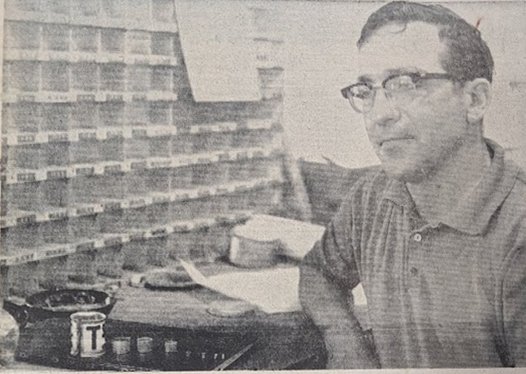Each week we’ll take a step back into the history of Great Bend through the eyes of reporters past. We’ll reacquaint you with what went into creating the Great Bend of today, and do our best to update you on what “the rest of the story” turned out to be.
It was on this date 50 years ago that the Soviet Union began drilling what would become known as the Kola Superdeep Borehole. Located in the Pechengsky District in Murmansk Oblast (just east of the far northern border between Russia and Finland, for us Americans) became the deepest artificial point on Earth in 1989. At 40,230 feet, that’s 7.619 miles. It continues to be the deepest vertical hole on Earth. It is only 8.7 inches in diameter.
It was also the world’s longest borehole until it was surpassed in 2008 by the 40,318 foot Al Shaheen Oil Well in Qatar, and in 2011 by the 40,502 foot Sakhalin-i Odoptu OP-11 well, a Russian offshore well.
The stated reasons were for research of seismic activity, geophysical examinations, and physical and chemical composition of the deep crust and the transition from upper to lower crust.


Much was learned, and you can read more about it at https://en.wikipedia.org/wiki/Kola_Superdeep_Borehole
The project ended in 1995 due to the dissolution of the Soviet Union, and the site has since been abandoned.[12] The ruins of the site, however, are frequently visited by curious sightseers.
According to one New York Post report, “Locals in the area say that the hole is so deep you can hear the screams of people being tortured in hell, hence its nickname being “the well to hell.”
The superstructure tower was destroyed at some point between 2007 and 2012. For more creepy information about the borehole, check out this post at Russian Urban Exploration (https://rusue.com/abandoned-kola-superdeep-borehole/).


Bricklayer picket
The new building for the Great Bend Public Library was under construction, and this week a member of the AFL-CIO Local 24, Hutchinson started picketing outside the east entrance on Friday morning. The bricklayer’s union was striking for higher pay, and were negotiating for a $3.73 an hour raise over the next three years, an increase that would nearly double their present wage of $4.85 an hour plus fringe benefits, according to the report in The Great Bend Daily Tribune.
The picket, Joseph Danek of Great Bend, was picketing because the contractor, McBride Dehmer Construction Co., was “doing bricklayers work with non-bricklayers.”
The contractor stated he had contacted the union to request a bricklayer for the job, but due to the strike, the request was denied. The work on the library could not wait.
The strike was also affecting work at the Barton County Community College, or “juco” as it was referred to in the paper.
By the end of the week, striking bricklayers were back at work after the strike was settled. There was no report on what the negotiations yielded. But, “At the juco Wednesday afternoon the bricklayers appeared to be making up for lost time,” according to a caption for one front page photo.


The bricklayers union may be the oldest continuously operating trade union in North America. It was founded in 1865 as the Bricklayers, Masons and Plasterers International Union of America (BMPIU). It was established during a great wave of blue-collar union formation in the 1860s.
Bug man turns birdman
In 1970, the State Board of Agriculture office in Great Bend was where Edmund Martinez , the District Entomologist, became an authority on “the birds and the bees.” The Tribune reported this week in 1970 that the bug man had a passion for birds.
“In spite of a heavy schedule of travelling and inspecting all over the western part of the state, Ed has managed to band more than 31,000 shore birds of various species since he got his banding license back in 1966.”


Bands from dead birds had been retrieved from as far away as Alberta, Canada and Argentina, and from Florida to California, the report stated. They were both common and exotic, including white egrets, ibis and herons.
While he admitted that sometimes the work can be very tiring and dirty, “the satisfaction of having done something to further man’s interest and knowledge of wildlife and its conservation is a tremendously satisfying feeling.”
Martinez, was interviewed for a June 12, 2001 report in the New York Times about his birding passion (https://www.nytimes.com/2001/06/12/science/in-the-prairie-heartland-a-wealth-of-shorebirds-gathers.html). At that time he was 67 years old. He no longer walked the marsh banding birds.
‘’It’s remarkable what passes through Cheyenne Bottoms,’’ he said in a recent interview. ‘’Sandpipers that winter in Tierra del Fuego and breed in Siberia, I got to hold them in my hand and marvel at how they do it. To get returns on birds that I banded from northern Russia and South America, it really put into perspective what is going on here in the center of Kansas. These small birds are the best athletes in the world.’’
The report went on to say at first, his findings were greeted with skepticism “because the numbers were unlike anything being reported anywhere else in the country.” They came to see for themselves, and were amazed at what they found.
We found no more recent information about Martinez, who would be around 85-87 today.


Just for fun
“Stripped”
We found a compelling photo on the front of the Monday, May 25, 1970 Tribune. Four young men stand atop a vehicle partially submerged in a lake, holding onto what appears to be a tow-rope.
“Swimmers attending a party at the Dartmouth sand pit Saturday afternoon discovered what appeared to be an automobile under the surface of the water. Investigation determined the 1969 model car was one stolen from Morrow Motors around May 12.
Swimmers and Detective Randy Smith worked for a considerable time before they were able to hook a heavy cable from a bulldozer to the submerged car.
Officers found the motor, transmission and bucket seats had been stripped from the car.
It wasn’t unusual to find young people enjoying some sunbathing or swimming, and the occasional party at the Dartmouth sand pit (between Great Bend and Ellinwood) back in the day, Tribune staff assured us. This occasion likely made this one unforgettable party, and the start of an exciting summer.





